Bringing the Bethnal Green disaster to light
After more than 170 people died in a tragic accident at Bethnal Green Tube station in 1943, the government tried to keep the details private for security reasons. But a court case brought by a victim changed everything.
Controlling the narrative
On Wednesday 3 March 1943, a horrific incident at Bethnal Green station resulted in 173 people losing their lives. A mother’s slip down the stairs led to a deadly crush among Londoners taking shelter there, as detailed in our previous article about The Bethnal Green Tube shelter disaster.
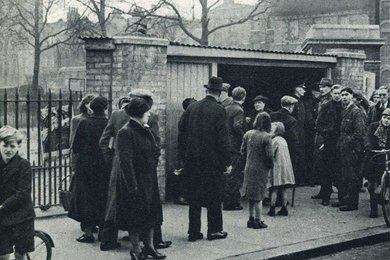
The entrance to Bethnal Green shelter as it was in 1943. Image: Chronicle / Alamy Stock Photo
Reporting restrictions during the Second World War meant that tragic events such as this were not immediately written about in the press. Not only was public morale a consideration, but so was the possibility of the enemy creating propaganda out of the situation.
Herbert Morrison, the Minister of Home Security from 1940 to 1945, issued a brief statement which was reported in the British press on 5 March. The location of the tragedy was not revealed, and it was emphasised that there was no panic in the crowd.
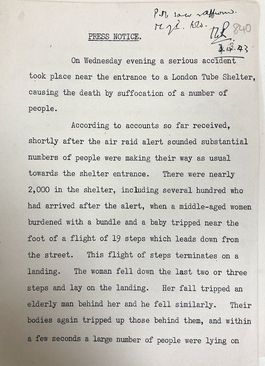
Transcript
PRESS NOTICE.
On Wednesday evening a serious accident took place near the entrance to a London Tube Shelter, causing the death by suffocation of a number of people.
According to accounts so far received, shortly after the air raid alert sounded substantial numbers of people were making their way as usual towards the shelter entrance. There were nearly 2,000 in the shelter, including several hundred who had arrived after the alert, when a middle-aged women burdened with a bundle and a baby tripped near the foot of a flight of 19 steps which leads down from the street. This flight of steps terminates on a landing. The women fell down the last two or three steps and lay on the landing. Her fall tripped an elderly man behind her and he fell similarly. Their bodies again tripped up those behind them, and within a few seconds a large number of people were lying on [continues on a further page]
PRESS NOTICE.
On Wednesday evening a serious accident took place near the entrance to a London Tube Shelter, causing the death by suffocation of a number of people.
According to accounts so far received, shortly after the air raid alert sounded substantial numbers of people were making their way as usual towards the shelter entrance. There were nearly 2,000 in the shelter, including several hundred who had arrived after the alert, when a middle-aged women burdened with a bundle and a baby tripped near the foot of a flight of 19 steps which leads down from the street. This flight of steps terminates on a landing. The women fell down the last two or three steps and lay on the landing. Her fall tripped an elderly man behind her and he fell similarly. Their bodies again tripped up those behind them, and within a few seconds a large number of people were lying on [continues on a further page]
Herbert Morrison’s press release. Catalogue reference: PREM 4/40/15
However, a BBC report of foreign broadcasts showed a German claim that 'That sort of fairy tale can only be told a child or an Englishman. It is plain that as far as air raids are concerned, the nerves of Londoners seem to be on edge.'
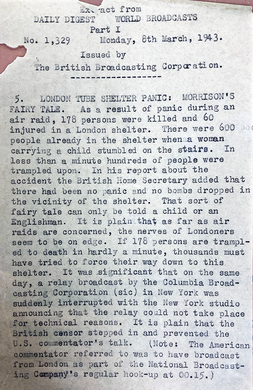
Transcript
Extract from
DAILY DIGEST WORLD BROADCASTS
Part I
No. 1,329 Monday, 8th March, 1943.
Issued by
The British Broadcasting Corporation.
5. LONDON TUBE SHELTER PANIC: MORRISON'S FAIRY TALE. As a result of panic during an air raid, 178 persons were killed and 60 injured in a London shelter. There were 600 people already in the shelter when a woman carrying a child stumbled on the stairs. In less than a minute hundreds of people were trampled upon. In his report about the accident the British Home Secretary added that there had been no panic and no bombs dropped in the vicinity of the shelter. That sort of fairy tale can only be told a child or an Englishman. It is plans that as far as air raids are concerned, the nerves of Londoners seem to be on edge. If 178 persons are trampled to death in hardly a minute, thousands must have tried to force their way down to this shelter. It was significant that on the same day, a relay broadcast by the Columbia Broadcasting Corporation (sic) in New York was suddenly interrupted with the New York studio announcing that the relay could not take place for technical reasons. It is plain that the British censor stepped in and prevented the U.S. commentator's talk. (Note: The American commentator referred to was to have broadcast from London as part of the National Broadcasting Company's regular hook-up at 00.15.)
Extract from
DAILY DIGEST WORLD BROADCASTS
Part I
No. 1,329 Monday, 8th March, 1943.
Issued by
The British Broadcasting Corporation.
5. LONDON TUBE SHELTER PANIC: MORRISON'S FAIRY TALE. As a result of panic during an air raid, 178 persons were killed and 60 injured in a London shelter. There were 600 people already in the shelter when a woman carrying a child stumbled on the stairs. In less than a minute hundreds of people were trampled upon. In his report about the accident the British Home Secretary added that there had been no panic and no bombs dropped in the vicinity of the shelter. That sort of fairy tale can only be told a child or an Englishman. It is plans that as far as air raids are concerned, the nerves of Londoners seem to be on edge. If 178 persons are trampled to death in hardly a minute, thousands must have tried to force their way down to this shelter. It was significant that on the same day, a relay broadcast by the Columbia Broadcasting Corporation (sic) in New York was suddenly interrupted with the New York studio announcing that the relay could not take place for technical reasons. It is plain that the British censor stepped in and prevented the U.S. commentator's talk. (Note: The American commentator referred to was to have broadcast from London as part of the National Broadcasting Company's regular hook-up at 00.15.)
BBC report of a German broadcast. Catalogue reference: HO 199/114
On Wednesday 10 March, Herbert Morrison made a statement to the House – an announcement in Parliament of a major incident or action – saying:
The Government have decided that an independent inquiry should be held, and I have appointed Mr Laurence Dunne, one of the Metropolitan Magistrates, to conduct an inquiry into the circumstances of the disaster […]
As many aspects of the incident concern Civil Defence arrangements related to acts of war, on which it is undesirable that information should be given to the enemy, the Government have decided in the national interest that the inquiry should be held in private; but the conclusions will, subject to security considerations, be published.
An inquiry – unpublished
Laurence Dunne opened his inquiry on Thursday 11 March and heard from 80 witnesses. Home Office files include letters from people offering to give evidence or suggesting alterations that could be made to improve safety. They also include letters, both signed and anonymous, blaming pickpockets, fascists, Jews, and negligent authorities for causing the disaster.
The Board of Deputies of British Jews and The Council of Christians and Jews both sent letters to the Home Office expressing concern about the rumours relating to their community.
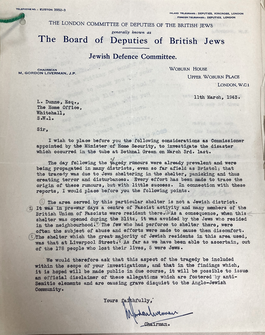
Partial transcript
Sir,
I wish to place before you the following considerations as Commissioner appointed by the Minister of Home Security, to investigate the disaster which occurred in the tube at Bethnal Green on March 3rd. last.
The day following the tragedy rumours were already prevalent and were being propagated in many districts, even so far afield as Bristol; that the tragedy was due to Jews sheltering in the shelter, panicking and thus creating terror and disturbances. Every effort has been made to trace the origin of these rumours, but with little success. In connection with these reports, I would place before you the following points.
1 The area served by this particular shelter is not a Jewish district. 2 It was in pre-war days a centre of Fascist activity and many members of the British Union of Fascists were resident there. 3 As a consequence, when this shelter was opened during the Blitz, it was avoided by the Jews who resided in the neighbourhood. 4 The few who had perforce to shelter there, were often the subject of abuse and efforts were made to cause them discomfort. 5 The shelter which the great majority of Jewish residents in this area used, was at Liverpool Street. 6 As far as we have been able to ascertain, out of the 178 people who lost their lives, 5 were Jews.
We would therefore ask that [...] it will be possible to issue an official disclaimer of these allegations which are fostered by anti-Semitic elements and are causing grave disquiet to the Anglo-Jewish Community.
Sir,
I wish to place before you the following considerations as Commissioner appointed by the Minister of Home Security, to investigate the disaster which occurred in the tube at Bethnal Green on March 3rd. last.
The day following the tragedy rumours were already prevalent and were being propagated in many districts, even so far afield as Bristol; that the tragedy was due to Jews sheltering in the shelter, panicking and thus creating terror and disturbances. Every effort has been made to trace the origin of these rumours, but with little success. In connection with these reports, I would place before you the following points.
1 The area served by this particular shelter is not a Jewish district. 2 It was in pre-war days a centre of Fascist activity and many members of the British Union of Fascists were resident there. 3 As a consequence, when this shelter was opened during the Blitz, it was avoided by the Jews who resided in the neighbourhood. 4 The few who had perforce to shelter there, were often the subject of abuse and efforts were made to cause them discomfort. 5 The shelter which the great majority of Jewish residents in this area used, was at Liverpool Street. 6 As far as we have been able to ascertain, out of the 178 people who lost their lives, 5 were Jews.
We would therefore ask that [...] it will be possible to issue an official disclaimer of these allegations which are fostered by anti-Semitic elements and are causing grave disquiet to the Anglo-Jewish Community.
Letter from The Board of Deputies of British Jews, 11 March 1943. Catalogue reference: HO 205/231
Laurence Dunne submitted his findings less than two weeks after opening the inquiry. However, at a War Cabinet meeting, ‘doubt was expressed as to the expediency of publishing a summary of Mr Dunne’s findings’ as this could ‘give the incident a disproportionate importance and might encourage the enemy to make further nuisance raids.’
Instead, Morrison made another statement to the House, saying that ‘It is impossible to make a fair summary of the report or even of the conclusions, without conveying information valuable to the enemy’. However, he did clarify that the report ‘dismisses as without foundation the rumours that the accident was caused by a Jewish panic or induced by Fascists or criminals for nefarious purposes.’
MPs raised objections, saying that failure to publish the findings of the inquiry would create speculation that the government was covering things up. Bethnal Green Council also objected strongly as they felt the absence of official conclusions fuelled speculation that the Council had been negligent. In fact, the Council had made numerous appeals to the London Civil Defence Region for funds to improve safety at the Bethnal Green shelter, but they had been turned down.
Baker v Bethnal Green Corporation (1944)
In July 1944, Annie Amelia Baker took out a test case against Bethnal Green Council. She sued the council for damages for personal injuries received in the Tube shelter disaster and claimed compensation and damages relating to the deaths of her husband George and daughter Minnie.
Annie’s case rested on the claim that the council had been negligent in its statutory duty to ‘make provision for the protection of persons from injury in the event of hostile attacks from the air’. Her contention was that the council had not provided a safe entrance because the steps were worn and uneven, there was no centre handrail, and the lighting was inadequate.
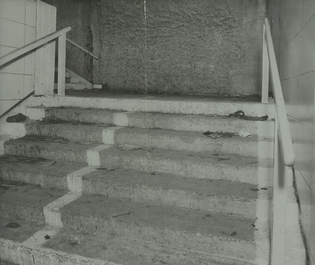
The Bethnal Green Tube shelter steps in 1943, photographed for the Dunne inquiry. Catalogue reference: HO 205/233
The council refuted the claims and said the accident was due to the size and urgency of the crowd trying to enter the shelter, and that the deaths and injuries sustained by the victims were war injuries covered by the Personal Injuries (Emergency Provisions) Act 1939. The council also claimed that section 3 of the Act precluded Annie from making an independent claim for damages against them.
The case was heard in private at the instruction of Herbert Morrison, but Mr Justice Singleton gave his ruling in public. He found in favour of Annie Baker, concluding that the council and wardens responsible for the shelter had been made aware of concerns about the lighting and the condition of the steps and had not taken appropriate action. He noted that following the tragedy changes to the steps and lighting were made, and a central handrail was installed. Annie was awarded £1,550 in damages.
The council appealed, but in December 1944 Lord Greene upheld the original decision. Lord Greene also criticised the decision to hear the case ‘in camera’ (i.e. not in public), saying that:
In the present case, so far as I understand it, however, the only ground of public security which influenced the mind of the Ministry was the possibility that suggestions might come out in evidence during the case which would point to there having been panic. But it was perfectly well known before ever the trial opened that there had been no panic.
Under the Public Authorities’ Protection Act, victims of the disaster and their families had to make claims for compensation within 12 months of the date of the event. According to newspaper reports, around 50 cases could not be considered because they were not made in time. The Daily Herald reported on 9 December 1944 that ‘In some cases the claimants were serving in the Middle East’ and so had not been able to pursue legal action.
Along with Annie Baker, 120 other claims had been made in time, and on 20 January 1944 The Daily Express reported that ‘Solicitors for all the claimants are negotiating with Bethnal Green Borough Council as to the amount of damages, which may total over £80,000’.
The Dunne report's findings
The outcome of Annie's case – and Lord Greene criticising its secrecy – led Herbert Morrison to arrange a statement to the House on 19 January 1945 in response. In the event, he was too ill to attend and Sir John Anderson (by then the Chancellor of the Exchequer) read out the statement on his behalf. It said that:
I do not think that the matter can now be seen in its proper perspective without disclosing Mr Dunne’s findings. Until recently security considerations have prevented the publication of his report, but after careful consideration I have come to the conclusion that circumstances have so changed since “D” Day that it can now be published without serious prejudice to the national interest. I have therefore arranged for publication of the report.
The report summarised the events of 3 March 1943 as follows:
At precisely 8.27pm a salvo of rockets was discharged from a battery some third of a mile away. This caused a great deal of alarm. Some people on their way to the shelter lay down in the road and then ran on. There were some cries reported that “they were starting dropping them”: that it was a land mine; and other alarming observations. The crowd surged forward towards the entrance carrying in front of it those who were entering the shelter, and placing a severe and sudden pressure upon the backs of those already descending the nearly dark stairway.
Included in the report was a section illustrating the attempts of the council to obtain funding for improvements to the shelter entrance. The council had been concerned that pressure from crowds could collapse the wooden structure surrounding the entrance, instead of focusing on the safety of the stairway or the lighting.
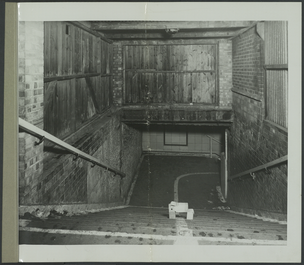
Photograph from the Dunne report showing just inside the Bethnal Green Tube shelter entrance. Catalogue reference: HO 205/233
Dunne made the point that the council had considered that renewed air attacks would cause an increase to the people seeking shelter in the Tube tunnels, and that this could have safety implications.
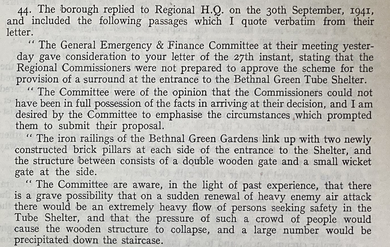
Transcript
44. The borough replied to Regional H.Q. on the 30th September, 1941, and included the following passages which I quote verbatim from their letter.
" The General Emergency & Finance Committee at their meeting yesterday gave consideration to your letter of the 27th instant, stating that the Regional Commissioners were not prepared to approve the scheme for the provision of a surround at the entrance to the Bethnal Green Tube Shelter.
" The Committee were of the opinion that the Commissioners could not have been in full possession of the facts in arriving at their decision, and I am desired by the Committee to emphasise the circumstances which prompted them to submit their proposal.
" The iron railings of the Bethnal Green Gardens link up with two newly constructed brick pillars at each side of the entrance to the Shelter, and the structure between consists of a double wooden gate and a small wicket gate at the side.
" The Committee are aware, in the light of past experience, that there is a grave possibility that on a sudden renewal of heavy enemy air attack there would be an extremely heavy flow of persons seeking safety in the Tube Shelter, and that the pressure of such a crowd of people would cause the wooden structure to collapse, and a large number would be precipitated down the staircase.
44. The borough replied to Regional H.Q. on the 30th September, 1941, and included the following passages which I quote verbatim from their letter.
" The General Emergency & Finance Committee at their meeting yesterday gave consideration to your letter of the 27th instant, stating that the Regional Commissioners were not prepared to approve the scheme for the provision of a surround at the entrance to the Bethnal Green Tube Shelter.
" The Committee were of the opinion that the Commissioners could not have been in full possession of the facts in arriving at their decision, and I am desired by the Committee to emphasise the circumstances which prompted them to submit their proposal.
" The iron railings of the Bethnal Green Gardens link up with two newly constructed brick pillars at each side of the entrance to the Shelter, and the structure between consists of a double wooden gate and a small wicket gate at the side.
" The Committee are aware, in the light of past experience, that there is a grave possibility that on a sudden renewal of heavy enemy air attack there would be an extremely heavy flow of persons seeking safety in the Tube Shelter, and that the pressure of such a crowd of people would cause the wooden structure to collapse, and a large number would be precipitated down the staircase.
Notes on Bethnal Green Council’s attempts to get funding for improvements. Catalogue reference: PREM 40/4/15
Dunne concluded that to prevent a recurrence of the situation that arose at Bethnal Green, authorities should consider ‘protecting the entrance from direct pressure by a crush barrier’ and that ‘entrances should where possible be so screened that stairways and the like can be properly lighted.’ His third recommendation was that ‘The provision of handrails should at least be considered. In a lighted way they should help.’
The final paragraph of Dunne's report raised objections from those involved in the tragedy. He made two propositions that questioned the behaviour of the crowds that evening:
(a) This disaster was caused by a number of people losing their self control at a particularly unfortunate place and time.
(b) No forethought in the matter of structural design or practicable police supervision can be any real safeguard against the effects of a loss of self control by a crowd. The surest protection must always be that self control and practical common sense, the display of which has hitherto prevented the people of this country being the victims of countless similar disasters.
Newspapers reported that the families of those killed and injured rejected the finding. Their legal representatives commented that the evidence heard in the inquiry was not subjected to cross examination, meaning Laurence Dunne had based his conclusions on untested evidence.
Remembering the tragedy
Fifty years on from the disaster, a plaque was erected on the staircase to Bethnal Green station where the tragedy occurred. The words on the plaque describe the event as the ‘worst civilian disaster of the Second World War.’
Subsequently, in 2007, the Stairway to Heaven Trust was established and work began to raise funds for a more visible and fitting memorial. In 2017 this was erected and now sits just outside the station in Bethnal Green Gardens.
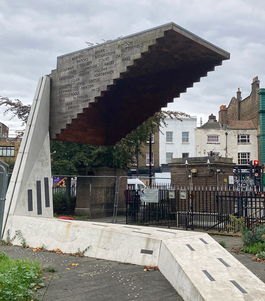
The Bethnal Green Tube disaster memorial. Image: Sarah Castagnetti
Designed by Harry Paticas, a local architect, the memorial is an open inverted stairway made of teak, hanging above a concrete plinth. The names of the dead are carved on the outside of the stairway and each person is also represented by a small hole which light shines through.
Records featured in this article
-
- Title
- Papers from the Prime Minister's Office on the Bethnal Green Tube shelter disaster
- Date
- March 1943 to January 1945
-
- Title
- The Dunne report into the disaster
- Date
- 1943
